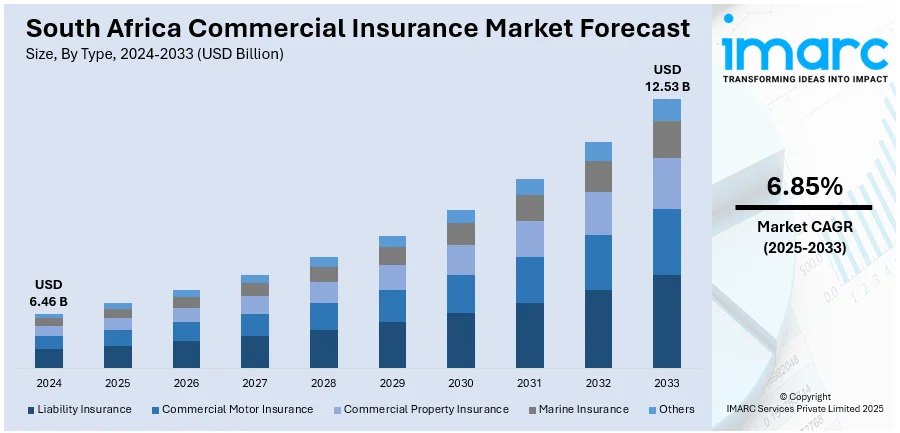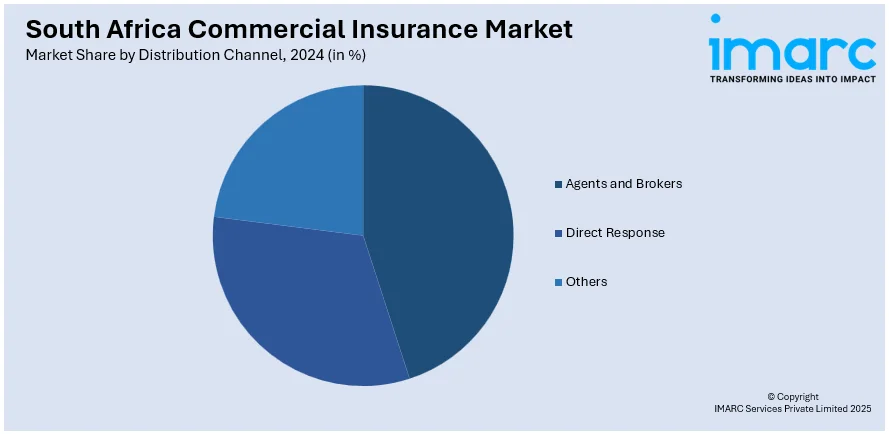
South Africa Commercial Insurance Market Size, Share, Trends and Forecast by Type, Enterprise Size, Distribution Channel, Industry Vertical, and Region, 2025-2033
South Africa Commercial Insurance Market Overview:
The South Africa commercial insurance market size reached USD 6.46 Billion in 2024. The market is projected to reach USD 12.53 Billion by 2033, exhibiting a growth rate (CAGR) of 6.85% during 2025-2033. Economic diversification, digital distribution via mobile channels, rising cyber‑risk awareness, and SME and informal sector growth drive demand. Regulatory support for innovation and micro‑insurance solutions underpin sector evolution, influencing South Africa commercial insurance market share.
|
Report Attribute
|
Key Statistics
|
|---|---|
|
Base Year
|
2024
|
|
Forecast Years
|
2025-2033
|
|
Historical Years
|
2019-2024
|
| Market Size in 2024 | USD 6.46 Billion |
| Market Forecast in 2033 | USD 12.53 Billion |
| Market Growth Rate (2025-2033) | 6.85% |
South Africa Commercial Insurance Market Trends:
Mobile and Digital Reach for SMEs
South Africa’s commercial insurance market is expanding reach to SMEs and informal businesses through mobile and digital platforms, boosting South Africa commercial insurance market growth. Insurers and insurtechs leverage mobile apps, USSD channels, and online portals to offer accessible underwriting and policy management. Flexible digital interfaces cater to varied literacy and connectivity levels, facilitating broader inclusion. Embedded insurance partnerships with fintech and micro‑lending providers extend product distribution into rural and peri‑urban markets. Digital issuance shortens onboarding times and lowers operational costs. As small enterprises seek agility and affordability, digital channels become pivotal. This trend underscores South Africa’s progress in bridging the insurance gap within underbanked and nascent business segments. For instance, in October 2024, Land Bank Insurance Company (LBIC) partnered with CelsiusPro to pilot index-based drought insurance for smallholder farmers in South Africa. Supported by the Natural Disaster Fund, the initiative covers five provinces and aims to offer faster, automated payouts without assessors. CelsiusPro’s digital platform will manage pricing, monitoring, and claims. The program targets nearly 250,000 smallholder farmers and 1.5 million subsistence farmers, enhancing climate resilience and addressing insurance gaps in agriculture.

To get more information on this market, Request Sample
Regulatory Innovation and Micro‑Insurance
South Africa’s Financial Sector Conduct Authority (FSCA) is piloting frameworks promoting micro‑insurance and modular commercial policies, fueling South Africa commercial insurance market growth. Regulatory innovations encourage simplified, usage‑based insurance for SMEs and informal sector participants. Licensed insurers partner with community organizations and mobile networks to distribute affordable, event‑based coverage. Products include limited‑duration liability or supply‑chain interruption modules tied to mobile premiums. Policymakers monitor risk segmentation and consumer outcomes to ensure transparency and fairness. These pilot regimes reduce entry barriers for new offerings and promote experimentation. As the risk landscape grows more complex, regulatory encouragement of adaptable coverage supports broader insurance inclusion and expansion across South Africa’s heterogeneous market. For instance, in October 2024, South Africa’s state-owned insurer Sasria considered expanding its coverage to include natural disasters, climate risks, and cyber threats. This move follows improved financial reserves and recent severe weather events. The expansion would require amendments to the Sasria Act, aiming to develop a disaster risk pool in collaboration with the private sector.
South Africa Commercial Insurance Market Segmentation:
IMARC Group provides an analysis of the key trends in each segment of the market, along with forecasts at the country and regional level for 2025-2033. Our report has categorized the market based on type, enterprise size, distribution channel, and industry vertical.
Type Insights:
- Liability Insurance
- Commercial Motor Insurance
- Commercial Property Insurance
- Marine Insurance
- Others
The report has provided a detailed breakup and analysis of the market based on the type. This includes liability insurance, commercial motor insurance, commercial property insurance, marine insurance, and others.
Enterprise Size Insights:
- Large Enterprises
- Small and Medium-sized Enterprises
The report has provided a detailed breakup and analysis of the market based on the enterprise size. This includes large enterprises and small and medium-sized enterprises.
Distribution Channel Insights:

- Agents and Brokers
- Direct Response
- Others
The report has provided a detailed breakup and analysis of the market based on the distribution channel. This includes agents and brokers, direct response, and others.
Industry Vertical Insights:
- Transportation and Logistics
- Manufacturing
- Construction
- IT and Telecom
- Healthcare
- Energy and Utilities
- Others
The report has provided a detailed breakup and analysis of the market based on the industry vertical. This includes transportation and logistics, manufacturing, construction, it and telecom, healthcare, energy and utilities, and others.
Regional Insights:
- Gauteng
- KwaZulu-Natal
- Western Cape
- Mpumalanga
- Eastern Cape
- Others
The report has also provided a comprehensive analysis of all the major provinces, which include Gauteng, KwaZulu-Natal, Western Cape, Mpumalanga, Eastern Cape, and others.
Competitive Landscape:
The market research report has also provided a comprehensive analysis of the competitive landscape. Competitive analysis such as market structure, key player positioning, top winning strategies, competitive dashboard, and company evaluation quadrant has been covered in the report. Also, detailed profiles of all major companies have been provided.
South Africa Commercial Insurance Market News:
- In July 2025, Santam Limited, a leading South African general insurer, secured in-principle approval from Lloyd’s of London to establish a syndicate in the UK. Subject to operational compliance, the syndicate is expected to begin underwriting on January 1, 2026. The move supports Santam’s global expansion strategy, offering access to 77 insurance and 200 reinsurance markets. It will draw on Santam’s expertise and benefit from Lloyd’s credit ratings, aiming to boost international earnings while diversifying operations.
South Africa Commercial Insurance Market Report Coverage:
| Report Features | Details |
|---|---|
| Base Year of the Analysis | 2024 |
| Historical Period | 2019-2024 |
| Forecast Period | 2025-2033 |
| Units | Billion USD |
| Scope of the Report |
Exploration of Historical Trends and Market Outlook, Industry Catalysts and Challenges, Segment-Wise Historical and Future Market Assessment:
|
| Types Covered | Liability Insurance, Commercial Motor Insurance, Commercial Property Insurance, Marine Insurance, Others |
| Enterprise Sizes Covered | Large Enterprises, Small and Medium-sized Enterprises |
| Distribution Channels Covered | Agents and Brokers, Direct Response, Others |
| Industry Verticals Covered | Transportation and Logistics, Manufacturing, Construction, IT and Telecom, Healthcare, Energy and Utilities, Others |
| Regions Covered | Gauteng, KwaZulu-Natal, Western Cape, Mpumalanga, Eastern Cape, Others |
| Customization Scope | 10% Free Customization |
| Post-Sale Analyst Support | 10-12 Weeks |
| Delivery Format | PDF and Excel through Email (We can also provide the editable version of the report in PPT/Word format on special request) |
Key Questions Answered in This Report:
- How has the South Africa commercial insurance market performed so far and how will it perform in the coming years?
- What is the breakup of the South Africa commercial insurance market on the basis of type?
- What is the breakup of the South Africa commercial insurance market on the basis of enterprise size?
- What is the breakup of the South Africa commercial insurance market on the basis of distribution channel?
- What is the breakup of the South Africa commercial insurance market on the basis of industry vertical?
- What is the breakup of the South Africa commercial insurance market on the basis of region?
- What are the various stages in the value chain of the South Africa commercial insurance market?
- What are the key driving factors and challenges in the South Africa commercial insurance market?
- What is the structure of the South Africa commercial insurance market and who are the key players?
- What is the degree of competition in the South Africa commercial insurance market?
Key Benefits for Stakeholders:
- IMARC’s industry report offers a comprehensive quantitative analysis of various market segments, historical and current market trends, market forecasts, and dynamics of the South Africa commercial insurance market from 2019-2033.
- The research report provides the latest information on the market drivers, challenges, and opportunities in the South Africa commercial insurance market.
- Porter's Five Forces analysis assists stakeholders in assessing the impact of new entrants, competitive rivalry, supplier power, buyer power, and the threat of substitution. It helps stakeholders to analyze the level of competition within the South Africa commercial insurance industry and its attractiveness.
- Competitive landscape allows stakeholders to understand their competitive environment and provides an insight into the current positions of key players in the market.
Need more help?
- Speak to our experienced analysts for insights on the current market scenarios.
- Include additional segments and countries to customize the report as per your requirement.
- Gain an unparalleled competitive advantage in your domain by understanding how to utilize the report and positively impacting your operations and revenue.
- For further assistance, please connect with our analysts.
 Request Customization
Request Customization
 Speak to an Analyst
Speak to an Analyst
 Request Brochure
Request Brochure
 Inquire Before Buying
Inquire Before Buying




.webp)




.webp)












